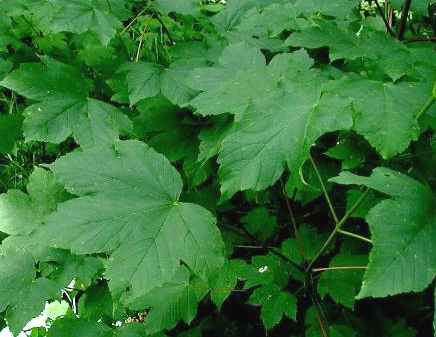|
SYCAMORE TREES
|
||
|
HOME | BIOLOGY | FILMS | GEOGRAPHY | HISTORY | INDEX | INVESTORS | MUSIC | NEWS | SOLAR BOATS | SPORT |
||
|
Sycamore is a name which is applied at various times and places to three very different types of trees, but with somewhat similar leaf forms.
The Sycamore or Sycamore Maple (Acer pseudoplatanus) is one of the most common maples in Europe, native to central Europe from France east to Poland, and south (in mountains) to northernmost Spain and Turkey. Sycamores now occur throughout Britain and Ireland, having been introduced in the 17th century.
Maple Sycamore leaves
The sycamore is a deciduous tree that reaches 20–35 m tall at maturity, with a broad, domed crown. On young trees, the bark is smooth and grey but becomes rougher with age and breaks up in scales, exposing the pale-brown-to-pinkish inner bark.
The leaves are opposite, 10-25 cm long and broad with a 5-15 cm petiole, palmately-veined with five lobes with toothed edges, and dark green in colour; some cultivars have purple-tinged or yellowish leaves.
The monoecious yellow-green flowers are produced in spring on 10-20 cm pendulous racemes, with 20-50 flowers on each stalk. The 5-10 mm diameter seeds are paired in samaras, each seed with a 20-40 mm long wing to catch the wind and rotate when they fall; this helps them to spread further from the parent tree. The seeds are mature in autumn about 6 months after pollination.
The name "sycamore" originally belongs to the fig species Ficus sycomorus native to southwest Asia (this is the sycamore or sycomore referred to in the Bible), and was later misapplied to this species (and others; see also Platanus) by reason of the superficial similarity in leaf shape. To avoid confusion, the name Sycamore Maple is used here.
Sycamore - Acer Pseudoplatanus leaves
Cultivation and uses
The Sycamore Maple is noted for its tolerance of wind, urban pollution and salt spray, which makes it a popular tree for planting in cities, along roads treated with salt in winter, and in coastal localities. It is cultivated and widely naturalised north of its native range in northern Europe, notably in the British Isles and Scandinavia north to Tromsø, Norway; Reykjavík, Iceland, and Torshavn on the Faroe Islands. In North America, escapes from cultivation are most common in New England, New York City and the Pacific Northwest. It is planted in many temperate parts of the Southern Hemisphere, most commonly in New Zealand and on the Falkland Islands. The popular cultivar 'Brilliantissimum' is notable for the bright salmon-pink colour of the young foliage.
Sycamore is planted for timber production; the wood is white with a silky lustre, and hard-wearing, used for furniture and flooring. Occasional trees produce wood with a wavy grain, greatly increasing the value for decorative veneers. European sycamore is a traditional wood used in creating necks, backs, and scrolls for violins.
Sycamore flowers produce abundant nectar, which makes a fragrant, delicately flavoured and pale-coloured honey.
The occupiers of a historic building in the village of Herstmonceux in East Sussex, had a lucky escape yesterday evening at about 3:00 am in the morning of Friday 24th August 2007. A wind got up and literally blew a large old oak tree over. In the process, missing a Jeep parked in the drive by inches.
LINKS
www.kinfonet.org/community/centres/sycamore/Tree.html
Nelson cutting down dangerous sycamore with a chainsaw August 2007
ROYAL FORESTRY SOCIETY
The Royal Forestry Society was born way back in 1882 when a group of foresters in Northumberland got together to exchange news and views about silviculture. It had 71 members.
They are a Registered Charity (No. 306093) and a charitable company limited by guarantee incorporated in England & Wales (No. 5306975). Our Registered Office is at 102 High Street, Tring, Herts HP23 4AF.
Anyone can join the RFS and they now have over 4,000 members drawn from right across the board - woodland owners, land managers, foresters, students, keen amateurs, arborists, landscapers, timber merchants, ecologists.
They publish a popular magazine - the Quarterly Journal of Forestry - putting on outdoor meetings, organising study tours nationally and internationally, running exams, managing model woodlands and a host of other activities highlighted under News & Events
TREE A - Z
FFS
Registered Office is at:
Permanent
staff comprises Dr John Jackson - Chief Executive; Linda Clements - Office
Manager; Jo Gagjee - Membership Secretary; and Linda Levy - Typist. Honorary Officers are elected at the AGM each May.
The
Editor is Lesley Trotter from Cornwall who can be contacted on qjf@talktalk.net
Healthier alternative tastes for adventure capitalists
Solar Red | Solar Crush + | Solar Cola | Solar Citrus + | Solar +
|
||
|



